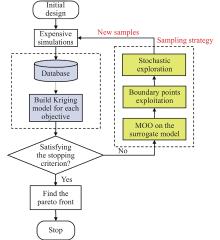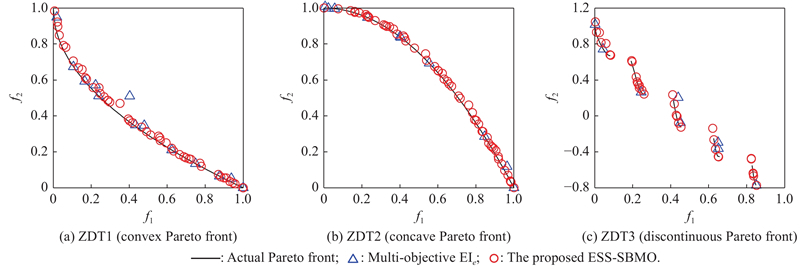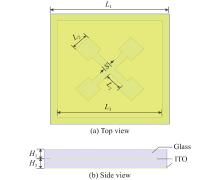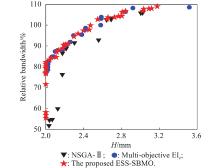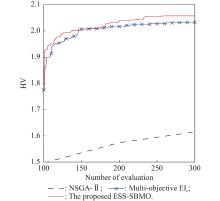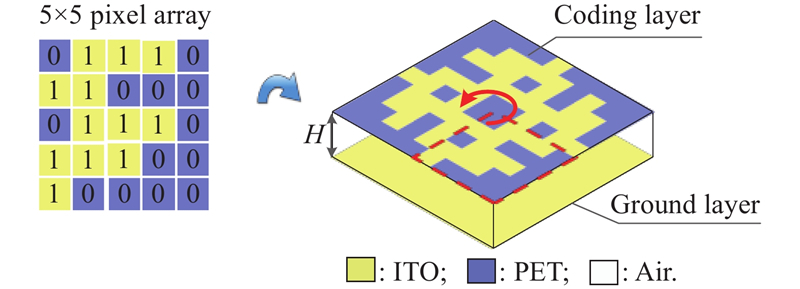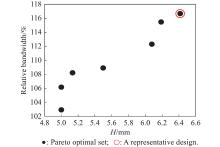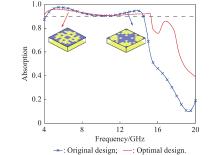Journal of Systems Engineering and Electronics ›› 2024, Vol. 35 ›› Issue (6): 1388-1396.doi: 10.23919/JSEE.2024.000036
• • 上一篇
-
收稿日期:2022-11-08接受日期:2024-01-04出版日期:2024-12-18发布日期:2025-01-14
Efficient sampling strategy driven surrogate-based multi-objective optimization for broadband microwave metamaterial absorbers
Sixing LIU1( ), Changbao PEI1(
), Changbao PEI1( ), Xiaodong YE1(
), Xiaodong YE1( ), Hao WANG1(
), Hao WANG1( ), Fan WU2(
), Fan WU2( ), Shifei TAO1,*(
), Shifei TAO1,*( )
)
- 1 School of Electronic and Optical Engineering, Nanjing University of Science and Technology, Nanjing 210094, China
2 School of Mechanical Engineering, Nanjing University of Science and Technology, Nanjing 210094, China
-
Received:2022-11-08Accepted:2024-01-04Online:2024-12-18Published:2025-01-14 -
Contact:Shifei TAO E-mail:sixingliu@njust.edu.cn;cbpei@njust.edu.cn;13851545785@163.com;haowang@mail.njust.edu.cn;wufan@njust.edu.cn;s.tao@njust.edu.cn -
About author:
LIU Sixing was born in 1997. She received her B.E. degree in measurement and control technology and instrumentation program in Hubei University of Technology, Wuhan, China, in 2019. She is currently pursuing her Ph.D. degree in electric science and technology with Nanjing University of Science and Technology. Her current research interests include metasurfaces design and surrogate model optimization algorithm. E-mail: sixingliu@njust.edu.cn
PEI Changbao was born in 1997. He received his B.S. degree from West Anhui University in 2020. He is pursuing his M.S. degree in the Department of Electrical Engineering at Nanjing University of Science and Technology. His main research interests include designs of metamaterial absorber and radar cross section reduction technology. E-mail: cbpei@njust.edu.cn
YE Xiaodong was born in 1967. He received his B.S. degree in Nanjing University of Posts and Telecommunications, China, in 1990, M.Sc. degree in the 14th Institute of China Electronics Technology Group Corporation, China, in 1993, and D.Sc. degree in Nanjing University of Aeronautics and Astronautics in 1997. His main research interests include signal processing and radar technology. E-mail: 13851545785@163.com
WANG Hao was born in 1980. He received his B.S. and Ph.D. degrees in electrical engineering from Nanjing University of Science and Technology, Nanjing, China, in 2002 and 2009, respectively. He is a professor with the School of Electronic and Optical Engineering, Nanjing University of Science and Technology. His current research interests include microstrip antennas for wireless communications and terminal antenna subsystem for compass navigation satellite system. E-mail: haowang@mail.njust.edu.cn
WU Fan was born in 1988. He received his B.S. degree in safety technology and engineering from Beijing University of Chemical Technology, Beijing, China, in 2013. He received his Ph.D. degree in disaster prevention and mitigation and protection engineering from Army Engineering University of PLA, Nanjing, China, in 2017. He is an associate professor in the School of Mechanical Engineering, Nanjing University of Science and Technology. His current research interests include design and development of absorbing and electromagnetic shielding materials. E-mail: wufan@njust.edu.cn
TAO Shifei was born in 1987. He received his B.Sc. and Ph.D. degrees from the Department of Communication Engineering, Nanjing University of Science and Technology (NJUST), Nanjing, China, in 2008 and 2014, respectively. Since 2017, he has been with NJUST, and now he is an associate professor in the School of Electronic and Optical Engineering, NJUST. From 2015 to 2016, he was a postdoctoral research associate in the Department of Electronic and Computer Engineering in Northeastern University, Boston, USA. His current research interests are in the electromagnetic theory and antenna technology, synthetic aperture radar images processing. E-mail: s.tao@njust.edu.cn -
Supported by:This work was supported by the National Key Research and Development Program (2021YFB3502500).
引用本文
. [J]. Journal of Systems Engineering and Electronics, 2024, 35(6): 1388-1396.
Sixing LIU, Changbao PEI, Xiaodong YE, Hao WANG, Fan WU, Shifei TAO. Efficient sampling strategy driven surrogate-based multi-objective optimization for broadband microwave metamaterial absorbers[J]. Journal of Systems Engineering and Electronics, 2024, 35(6): 1388-1396.
"
| Metrics | Benchmark | NSGA-Ⅱ | Multi-objective EIe | The proposed ESS-SBMO | |||||||||||
| Mean | Best | Worst | SD | Mean | Best | Worst | SD | Mean | Best | Worst | SD | ||||
| ONVG | ZDT1 | 24 | 35 | 15 | 12 | 15 | 10 | 52 | 59 | 40 | |||||
| ZDT2 | 10 | 19 | 3 | 9 | 11 | 3 | 56 | 63 | 50 | ||||||
| ZDT3 | 24 | 27 | 18 | 11 | 13 | 9 | 37 | 55 | 29 | ||||||
| HV | ZDT1 | ||||||||||||||
| ZDT2 | |||||||||||||||
| ZDT3 | |||||||||||||||
| 1 | CUI T J, SMITH D R, LIU R P. Metamaterials: theory, design, and applications. New York: Springer, 2009. |
| 2 |
TAO J Q, XU L L, PEI C B, et al Catfish effect induced by anion sequential doping for microwave absorption. Advanced Functional Materials, 2023, 33 (8): 2211996.
doi: 10.1002/adfm.202211996 |
| 3 |
WU L P, GAO H, GUO R H, et al MnO2 intercalation-guided impedance tuning of carbon/polypyrrole double conductive layers for electromagnetic wave absorption. Chemical Engineering Journal, 2023, 460, 141749.
doi: 10.1016/j.cej.2023.141749 |
| 4 | YAO X, HUANG Y Q, LI G Y, et al. Design of an ultra-broadband microwave metamaterial absorber based on multilayer structures. International Journal of RF and Microwave Computer-Aided Engineering, 2022, 32(8): e23222. |
| 5 |
LI W W, XU M Z, XU H X, et al Metamaterial absorbers: from tunable surface to structural transformation. Advanced Materials, 2022, 34 (38): 2202509.
doi: 10.1002/adma.202202509 |
| 6 |
KIM Y J, YOO Y J, KIM K W, et al Dual broadband metamaterial absorber. Optics Express, 2015, 23 (4): 3861- 3868.
doi: 10.1364/OE.23.003861 |
| 7 |
ZHANG Z, ZHANG L, CHEN X Q, et al Broadband metamaterial absorber for low-frequency microwave absorption in the S-band and C-band. Journal of Magnetism and Magnetic Materials, 2020, 497, 166075.
doi: 10.1016/j.jmmm.2019.166075 |
| 8 | PEI C B, LIU S X, DING Z D, et al. Design of multi-layer metamaterial absorbers using Kriging surrogate model. Proc. of the International Applied Computational Electromagnetics Society Symposium, 2022. DOI: 10.1109/ACES-China56081.2022.10065152. |
| 9 | MEI H, YANG W Q, YANG D, et al Metamaterial absorbers towards broadband, polarization insensitivity and tunability. Optics & Laser Technology, 2022, 147, 107627. |
| 10 | CUI T J, QI M Q, WAN X, et al Coding metamaterials, digital metamaterials and programmable metamaterials. Light: Science & Applications, 2014, 3 (10): e218. |
| 11 |
TRAN M C, PHAM V H, HO T H, et al Broadband microwave coding metamaterial absorbers. Scientific Reports, 2020, 10 (1): 1810.
doi: 10.1038/s41598-019-56847-4 |
| 12 |
RAMACHANDRAN T, FARUQUE M R I Impact of compact and novel 1-Bit coding based metamaterial design for microwave absorption applications. Journal of Magnetism and Magnetic Materials, 2022, 563, 170044.
doi: 10.1016/j.jmmm.2022.170044 |
| 13 | ZHANG J M, WANG G W, WANG T, et al Genetic algorithms to automate the design of metasurfaces for absorption bandwidth broadening. ACS Applied Materials & Interfaces, 2021, 13 (6): 7792- 7800. |
| 14 |
XIONG Y, CHEN F, CHENG Y Z, et al Ultra-thin optically transparent broadband microwave metamaterial absorber based on indium tin oxide. Optical Materials, 2022, 132, 112745.
doi: 10.1016/j.optmat.2022.112745 |
| 15 |
ZITZLER E, DEB K, THIELE L Comparison of multiobjective evolutionary algorithms: empirical results. Evolutionary Computation, 2000, 8 (2): 173- 195.
doi: 10.1162/106365600568202 |
| 16 | YANG K W, XIA B Y, CHEN G, et al Multi-objective optimization of operation loop recommendation for kill web. Journal of Systems Engineering and Electronics, 2022, 33 (4): 969- 985. |
| 17 |
DENG W, ZHANG X X, ZHOU Y Q, et al An enhanced fast non-dominated solution sorting genetic algorithm for multi-objective problems. Information Sciences, 2022, 585, 441- 453.
doi: 10.1016/j.ins.2021.11.052 |
| 18 |
MICHELI D, VRICELLA A, PASTORE R, et al Synthesis and electromagnetic characterization of frequency selective radar absorbing materials using carbon nanopowders. Carbon, 2014, 77, 756- 774.
doi: 10.1016/j.carbon.2014.05.080 |
| 19 | TOKTAS A, USTUN D. Dual-objective design of multilayer radar absorbing composite material using butterfly optimization algorithm. Proc. of the IEEE International Seminar/Workshop Direct and Inverse Problems of Electromagnetic and Acoustic Wave Theory, 2020: 77−81. |
| 20 |
FORRESTER A, KEANE A J Recent advances in surrogate-based optimization. Progress in Aerospace Sciences, 2009, 45 (1/3): 50- 79.
doi: 10.1016/j.paerosci.2008.11.001 |
| 21 |
ZHEN H X, GONG W Y, LING W Data-driven evolutionary sampling optimization for expensive problems. Journal of Systems Engineering and Electronics, 2021, 32 (2): 318- 330.
doi: 10.23919/JSEE.2021.000027 |
| 22 |
WANG W J, WU Z P, WANG D H, et al Surrogate-based optimization with adaptive parallel infill strategy enhanced by inaccurate multi-objective search. Engineering Optimization, 2022, 54 (8): 1356- 1373.
doi: 10.1080/0305215X.2021.1928109 |
| 23 |
JEONG S, MURAYAMA M, YAMAMOTO K Efficient optimization design method using Kriging model. Journal of Aircraft, 2005, 42 (2): 413- 420.
doi: 10.2514/1.6386 |
| 24 | TOAL D, KEANE A J Performance of an ensemble of ordinary, universal, non-stationary and limit Kriging predictors. Structural & Multidisciplinary Optimization, 2013, 47 (6): 893- 903. |
| 25 |
KOZIEL S, PIETRENKO-DABROWSKA A Performance-driven yield optimization of high-frequency structures by Kriging surrogates. Applied Sciences, 2022, 12 (7): 3697.
doi: 10.3390/app12073697 |
| 26 |
ABIODUN O I, JANTAN A, OMOLARA A E, et al State-of-the-art in artificial neural network applications: a survey. Heliyon, 2018, 4 (11): e00938.
doi: 10.1016/j.heliyon.2018.e00938 |
| 27 |
WANG J H, LIN Z C, FAN Y, et al Design of all-dielectric metasurface-based subtractive color filter by artificial neural network. Materials, 2022, 15 (19): 7008.
doi: 10.3390/ma15197008 |
| 28 |
GUTMANN H M A radial basis function method for global optimization. Journal of Global Optimization, 2001, 19 (3): 201- 227.
doi: 10.1023/A:1011255519438 |
| 29 |
MAJDISOVA Z, SKALA V Radial basis function approximations: comparison and applications. Applied Mathematical Modelling, 2017, 51, 728- 743.
doi: 10.1016/j.apm.2017.07.033 |
| 30 |
ZHOU J, SU X S, CUI G An adaptive Kriging surrogate method for efficient joint estimation of hydraulic and biochemical parameters in reactive transport modeling. Journal of Contaminant Hydrology, 2018, 216, 50- 57.
doi: 10.1016/j.jconhyd.2018.08.005 |
| 31 | LIU B, GROUT V, NIKOLAEVA A Efficient global optimization of actuator based on a surrogate model assisted hybrid algorithm. IEEE Trans. on Industrial Electronics, 2017, 65 (7): 5712- 5721. |
| 32 |
PARK S G, NA J G, KIM M J, et al Multi-objective Bayesian optimization of chemical reactor design using computational fluid dynamics. Computers and Chemical Engineering, 2018, 119, 25- 37.
doi: 10.1016/j.compchemeng.2018.08.005 |
| 33 |
PAL A, ZHU L, WANG Y, et al Constrained surrogate-based engine calibration using lower confidence bound. IEEE/ASME Trans. on Mechatronics, 2021, 26 (6): 3116- 3127.
doi: 10.1109/TMECH.2021.3053246 |
| 34 |
LIU H T, ONG Y S, CAI J F A survey of adaptive sampling for global metamodeling in support of simulation-based complex engineering design. Structural and Multidisciplinary Optimization, 2018, 57 (1): 393- 416.
doi: 10.1007/s00158-017-1739-8 |
| 35 |
WAUTERS J, KEANE A J, DEGROOTE J Development of an adaptive infill criterion for constrained multi-objective asynchronous surrogate-based optimization. Journal of Global Optimization, 2020, 78 (1): 137- 160.
doi: 10.1007/s10898-020-00903-1 |
| 36 | COX D D, JOHN S. A statistical method for global optimization. Proc. of the IEEE International Conference on Systems, 1992: 1241−1246. |
| 37 |
JONES D R A taxonomy of global optimization methods based on response surfaces. Journal of Global Optimization, 2001, 21 (4): 345- 383.
doi: 10.1023/A:1012771025575 |
| 38 |
JONES D R, SCHONLAU M, WELCH W J Efficient global optimization of expensive black-box functions. Journal of Global Optimization, 1998, 13 (4): 455- 492.
doi: 10.1023/A:1008306431147 |
| 39 |
LI M Y, YI B, YANG Y An efficient global optimization method with multi-point infill sampling based on Kriging. Engineering Optimization, 2022, 54 (11): 1801- 1818.
doi: 10.1080/0305215X.2021.1960985 |
| 40 |
KNOWLES J ParEGO: a hybrid algorithm with on-line landscape approximation for expensive multiobjective optimization problems. IEEE Trans. on Evolutionary Computation, 2006, 10 (1): 50- 66.
doi: 10.1109/TEVC.2005.851274 |
| 41 |
KEANE A J Statistical improvement criteria for use in multiobjective design optimisation. AIAA Journal, 2006, 44 (4): 879- 891.
doi: 10.2514/1.16875 |
| 42 | BAUTISTA D C. A sequential design for approximating the pareto front using the expected pareto improvement function. Columbus: The Ohio State University, 2009. |
| 43 | EMMERICH M. Single-and multi-objective evolutionary design optimization assisted by Gaussian random field metamodels. Dortmund: Technische Universität Dortmund, 2005. |
| 44 |
ZHAN D W, CHENG Y S, LIU J Expected improvement matrix-based infill criteria for expensive multiobjective optimization. IEEE Trans. on Evolutionary Computation, 2017, 21 (6): 956- 975.
doi: 10.1109/TEVC.2017.2697503 |
| 45 |
LV Z M, WANG L Q, HAN Z Y, et al Surrogate-assisted particle swarm optimization algorithm with Pareto active learning for expensive multi-objective optimization. IEEE/CAA Journal of Automatica Sinica, 2019, 6 (3): 838- 849.
doi: 10.1109/JAS.2019.1911450 |
| 46 |
LI F, GAO L, GARG A, et al Two infill criteria driven surrogate-assisted multi-objective evolutionary algorithms for computationally expensive problems with medium dimensions. Swarm and Evolutionary Computation, 2021, 60, 100774.
doi: 10.1016/j.swevo.2020.100774 |
| 47 |
KOZIEL S, ABDULLAH M Machine-learning-powered EM-based framework for efficient and reliable design of low scattering metasurfaces. IEEE Trans. on Microwave Theory and Techniques, 2021, 69 (4): 2028- 2041.
doi: 10.1109/TMTT.2021.3061128 |
| 48 |
ZHANG J Z, TAFLANIDIS A A, MEDINA J C Sequential approximate optimization for design under uncertainty problems utilizing Kriging metamodeling in augmented input space. Computer Methods in Applied Mechanics and Engineering, 2017, 315, 369- 395.
doi: 10.1016/j.cma.2016.10.042 |
| 49 | YI J X, WU F L, ZHOU Q, et al. An active-learning method based on multi-fidelity Kriging model for structural reliability analysis. Structural and Multidisciplinary Optimization, 2021, 63: 173−195. |
| 50 |
ZIMMERMANN R On the condition number anomaly of Gaussian correlation matrices. Linear Algebra and its Applications, 2015, 466, 512- 526.
doi: 10.1016/j.laa.2014.10.038 |
| 51 | JIN Y C, WANG H D, TINKLE C, et al Data-driven evolutionary optimization: an overview and case studies. IEEE Trans. on Evolutionary Computation, 2018, 23 (3): 442- 458. |
| 52 | SHANG K, ISHIBUCHI H, HE L J, et al A survey on the hypervolume indicator in evolutionary multiobjective optimization. IEEE Trans. on Evolutionary Computation, 2020, 25 (1): 1- 20. |
| 53 |
DEB K, AGRAWAL S, PRATAP A, et al A fast elitist non-dominated sorting genetic algorithm for multi-objective optimization: NSGA-II. IEEE Trans. on Evolutionary Computation, 2002, 6, 182- 197.
doi: 10.1109/4235.996017 |
| 54 | VAN VELDHUIZEN D A, LAMONT G B. On measuring multiobjective evolutionary algorithm performance. Proc. of the Congress on Evolutionary Computation, 2000: 204−211. |
| 55 |
ZITZLER E, THIELE L Multiobjective evolutionary algorithms: a comparative case study and the strength Pareto approach. IEEE Trans. on Evolutionary Computation, 1999, 3 (4): 257- 271.
doi: 10.1109/4235.797969 |
| 56 |
SONG Z C, MIN P P, YANG L, et al A bilateral coding metabsorber using characteristic mode analysis. IEEE Antennas and Wireless Propagation Letters, 2022, 21, 1228- 1232.
doi: 10.1109/LAWP.2022.3162330 |
| 57 |
KIM J, CACIALLI F, GRANSTRoM M, et al Characterisation of the properties of surface-treated indium-tin oxide thin films. Synthetic Metals, 1999, 101 (1/3): 111- 112.
doi: 10.1016/S0379-6779(98)01127-8 |
| No related articles found! |
| 阅读次数 | ||||||
|
全文 |
|
|||||
|
摘要 |
|
|||||
